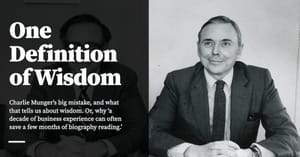How to pick tree books and branch books, demonstrated using an example of a reading program I developed for B2B sales.
A couple of years ago I published two blog posts that resonated with a large chunk of Commonplace’s readers. The first was The Three Kinds of Non-Fiction Books, and the second was The Land and Expand Strategy for Reading. In the years since I wrote those two posts, I’ve lost count of the number of times people have asked:
- How do you construct a reading program? And …
- How do you pick tree books vs branch books for a specific topic?
I thought it would be useful to answer these questions by way of a real-world example. This post should work on two levels: if you’re interested in B2B sales, you’ll probably enjoy the reading program that follows. And if you aren’t interested in B2B sales, this post will serve as an example of constructing a reading program from scratch. I’ll also explain the techniques I use to identify the tree and branch books that I mention below; more importantly, I’ll talk about how you might do it for whatever topic you want to investigate.
This post is split into three parts: first, I’ll explain the motivation for constructing this reading program. That way you know why I’ve picked the books that I have. Second, I’ll describe the reading program itself. This should be useful to you if you’re into learning B2B sales. Finally, I’ll explain the techniques I used to pick these books, so that you may use it for a topic of your own.
Let’s get started.
The Setup
I’m currently helping a B2B SaaS company named Holistics reposition their product offering. Over the past five weeks, I’ve run the company through April Dunford’s Obviously Awesome; we’re at the point in the process where we must iterate alongside the sales org to come up with something called a ‘sales narrative’ — a sequence of concepts that will best frame the product in the mind of customers. To cite Dunford:
“How I used to do this when I was internal as VP of Marketing at startups, I build this pitch, and then I would take my best salesperson — and what I’m trying to control for there is lousy salesmanship, right? This person must know how to sell — so I would take my best salesperson, I train them on this pitch, we go and find some prospects that look like the prospects I assume would love this pitch, and then we go test it. So how we test it is: my salesperson pitches, I’m also on the call, and I’m taking notes. And what I’m looking for is where is the customer getting confused, what kind of questions is the customer asking, where is the customer getting excited — I would take all kinds of notes, and then at the end of the pitch I would go back and sit with my sales rep and say “How do you think that went? What do you think was good and wasn’t good?” And I’ll be looking out for things like “You know there was that point where they said ‘So you’re just like Salesforce!’ and you’re like ‘ugh we’re not a CRM, why do they think we’re a CRM?’” which is a sign that your positioning is not working … or there’d be a part where folks got really really excited. So we’ll take the deck and tune it, and then we’d go back out and keep trying. And how I knew I had really good positioning is the point where my salesperson says ‘this deck is amazing and I’m not going back to the old one’.”
Except that I’m currently in Dunford’s shoes, and I’m listening to the sales calls asynchronously because we have Zoom recordings.
This closer collaboration with sales turns out to be problematic for me for a number of reasons. The biggest problem is that I think in terms of marketing, which is a different worldview compared to sales. Dunford argues that positioning is an internal input that feeds into pretty much every other company function (sales and marketing and customer support and product roadmap, and so on down the line) — if I am to execute on our repositioned marketing plan, then it’s likely that I have to do so while in closer collaboration with the sales organisation.
And my inability to talk to sales was beginning to slow us down.
Sometime last week, I started to execute an aggressive reading program on B2B sales, with two objectives:
- I wanted to understand the sales worldview. This would make it easier for me to talk to and work with the Holistics salespeople.
- I wanted to understand the recent meta (as opposed to the current meta) of the B2B sales game. I felt that the Holistics sales organisation wasn’t particularly well structured (there was no clear Ideal Customer Profile, and sales training was basically non-existent); I therefore wanted to know every mainstream organisational pattern for sales and marketing out there.
I had two advantages going into this reading program:
- I had credibility with the org, having run their content marketing strategy successfully for the past year. (I worked on their stuff two days a week)
- I had good relationships with the salespeople, and full access to every recording they made of their sales calls. So I might not be able to execute a sales call — at least not for the next couple of months! — but I could pattern-match my reading against what I saw in those recordings.
Originally published , last updated .
This article is part of the Expertise Acceleration topic cluster. Read more from this topic here→
This article is part of the Operations topic cluster, which belongs to the Business Expertise Triad. Read more from this topic here→





